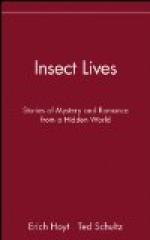Very exceptionally the imaginal stage may be omitted from the life-story altogether. Nearly fifty years ago N. Wagner (1865) made the remarkable discovery that in the larvae of certain gall-midges (Cecidomyidae) the ovaries might become precociously mature and unfertilised eggs might be developed into small larvae observable within the body of the mother-larva; ultimately these abnormally reared young break their way out. In this case therefore there may be a series of larval generations, neither pupa nor imago being formed. Extended observations on the precocious reproductive processes of these midges have lately been published by W. Kahle (1908). A less extreme instance of an abbreviated life-story was made known by O. Grimm (1870) who saw pupae of Harlequin-midges (Chironomus) lay unfertilised eggs, which developed into larvae. Here the imaginal stage only is omitted from the life-history. Not always however is it the imaginal stage of the life-history which is shortened. Reference (p. 18) has already been made to the case of the virgin female aphids, whose eggs develop within the mother’s body, so that active, formed young are brought forth. Among the Diptera it is not unusual to find similar cases, the female fly giving birth to young maggots instead of laying eggs. Such is the habit of the great flesh-fly (Sarcophaga), of some allied genera (Tachina, etc.) whose larvae live as parasites on other insects, and occasionally of the Sheep Bot-fly (Oestrus). In such cases we recognise the beginning of a shortened larval period, and Brace’s investigations in 1895, summarised by E.E. Austen (1911), have shown that females of the dreaded African Tsetse flies (Glossinia) bring forth nearly mature larvae, which pupate soon after birth. In another group of Diptera, the blood-sucking parasites of the Hippoboscidae and allied families, the whole larval development is passed through within the mother’s body, and a full-grown larva is born the cuticle of which hardens and darkens immediately to form a puparium; hence these flies are often called, though incorrectly,




